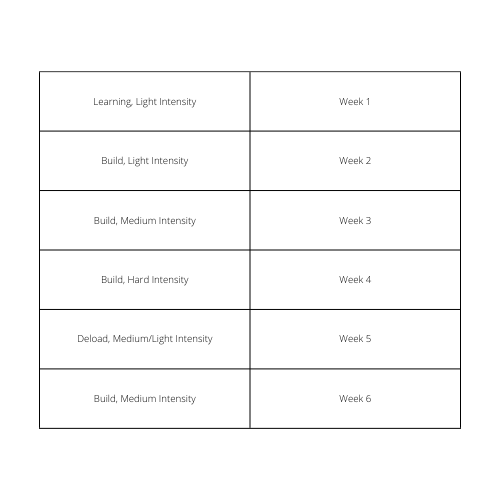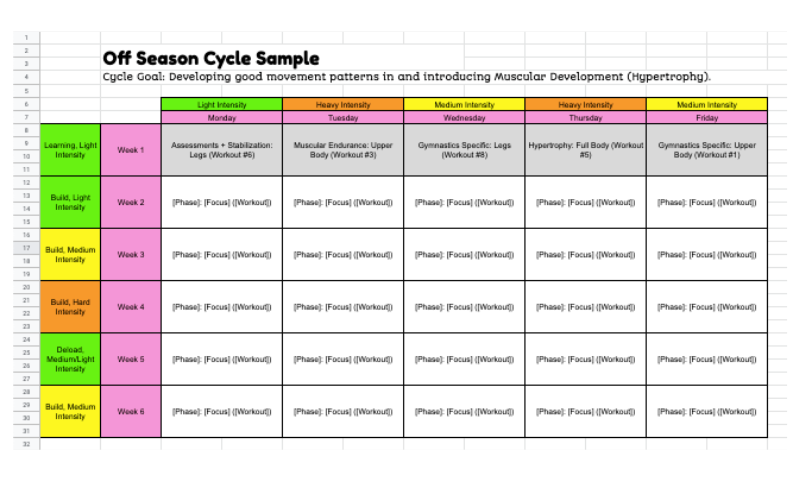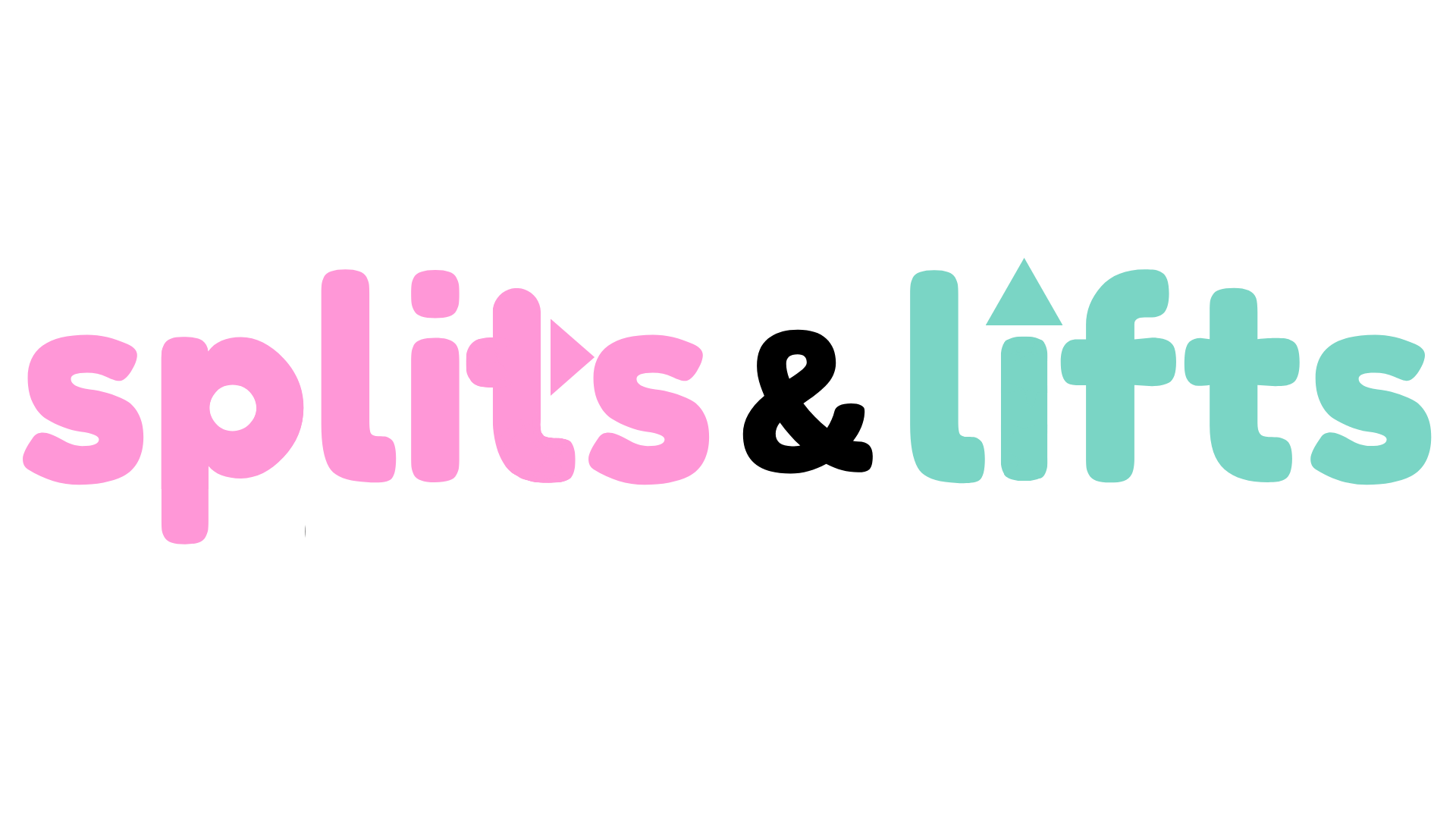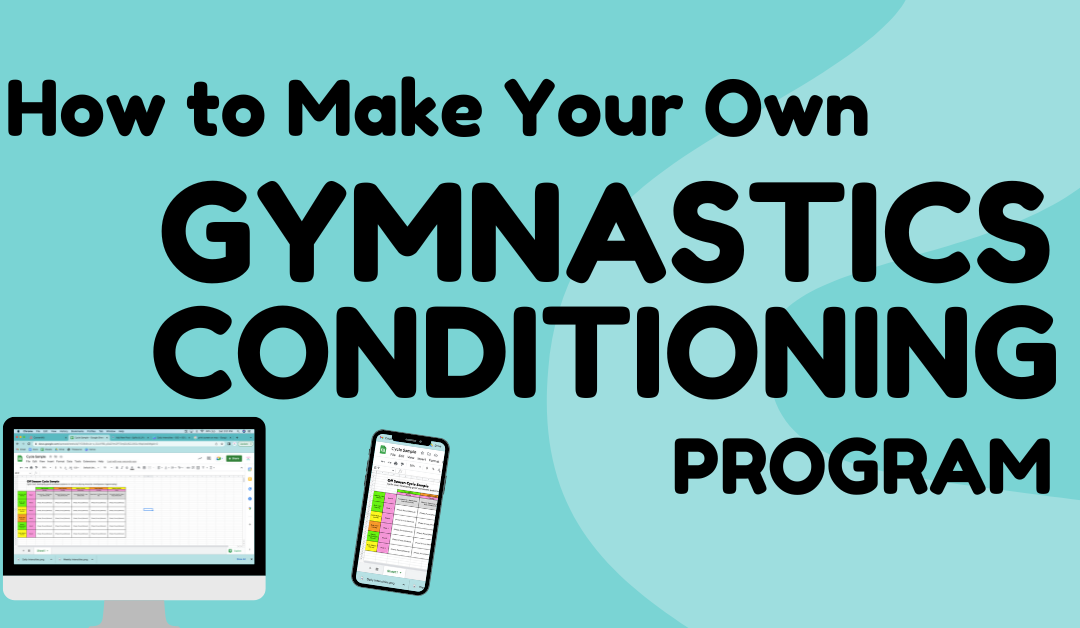Hoooo boy, time to grip up and get ripped, because I’m going to be taking you through the end-all-be-all, in-depth, (sometimes chaotic) world of creating a kick-butt, yearlong, gymnastics conditioning program.
I won’t lie, a solid gymnastics conditioning program is a process, and this step-by-step guide will get DEEP into the nitty-gritty. But I’m a strong believer that knowing why we do what we do helps keep us doing the dang thing.
I’ve tried to make this as straightforward as possible, but I recommend you follow along with the provided printouts, tips, and images to really kickstart this movement.
And if you don’t want to do all this, you can always hire me to do it for you. (Shameless plug.)
Anyhow, let’s get into it.
Step 1. Get a professional to conduct movement assessments.
This is technically optional, but I couldn’t recommend this step enough. We coaches are great at noticing positioning issues that apply to gymnastics, but most of us don’t have a background in basic athletic movement patterns.
A professional movement assessment can point out areas of weakness, imbalance, and even injuries waiting to happen.
What does a movement assessment look like?
A movement assessment is a series of basic exercises that provide feedback on common movement compensations. There are two steps to an effective assessment.
- Step 1. Identifying physical impairments such as knees going in during an overhead squat, or shoulders elevating during a cable push.
- Step 2. the professional can look at these impairments and identify which muscles are overly tight and which may need strengthening. When we know what’s going wrong (and right!), we can create the baseline for an effective program.
Any qualified personal trainer should be able to do this. However, if you’re looking for a trainer that also knows gymnastics, I do travel to perform assessments for gyms. I’ll print up a report of what these patterns mean for your gymnasts, and you can go ahead and skip step 2. Win-win!
Step 2. Find your patterns.
After conducting movement assessments, common themes of tight and weak muscles can be established. Generally, all the gymnasts are training in the same way, so this is super efficient for identifying strengths and weaknesses in the current gymnastics conditioning program.
Lots of knees going in during the squat assessment? Way too many shoulders shrugging?
I spy overactive adductors, TFL, and traps, and probably a need for a stronger posterior chain.
(But again, this is why you get the professional to interpret your findings!)
Step 3. Find your shared goals.
Most of the time when I ask coaches what their goals are for their gymnasts, they give me different answers than the gymnasts themselves.
For example, a recent client said her number one goal was to improve body shaping and to get rid of back pain on her team. When it was the gymnasts’ turn to respond, they cited “improved confidence” and “to get rid of heel pain” as their number one goals!
Including the gymnasts’ goals in a new program always creates more buy-in from the team.
Sometimes we don’t know that we’re not on the same page. But a good gymnastics conditioning program will incorporate all four of these goals to create one heck of a season.
Time to create a plan!
Once you’ve established your movement and performance goals, it’s time to put them into action. But where to start? Do we begin with day one? Actually, we’re going to work backwards.
Step 4. Start with your biggest meet of the season.
Look at the end goal. Whether it’s nationals or just your summer presentation for the parents, start with the big kahuna to schedule effectively.
From there, you can organize your schedule into seasons, phases, weeks, and days.
It feels like a lot, but hang in there!
Step 5. Train in seasons.
Lay out your schedule in seasons. This will lay the groundwork for not just when you train but how.
A good program will have conditioning that looks very different in-season than off-season.
Regardless of the schedule, I like to organize in four seasons: off-season, preseason, in-season, and postseason. Once you’ve defined these timelines (however makes sense for you and your team), it’s time to add in some phase work.
Step 6. Train in phases.
Here’s where things start to get fun! And a little nerdy, so hold on to your suspenders.
The NASM Optimum Performance Training Model is the most scientifically respected protocol for creating strong, powerful athletes. It’s used across all professional sports, and it’s what I use to build up my own bulletproof gymnasts.
This system uses 5 phases of progression:
- Stabilization –– establishing good movement patterns and solid balance
- Strength Endurance –– maintaining good patterns under time and tension
- Muscle Development –– creating muscular potential for future force and power
- Max Strength –– maximizing strength output and muscle potential
- Power –– speed, force, height, punch, and takeoff
Hold up!! I know you’re eyeing up that “Power” phase and rubbing your hands together just thinking about skipping to it, but take. a. step. back.
True, gymnasts are all power, all the time, but as fellow gymnastics conditioning coach Dan Lonsdale once said, “Gymnastics is unique, not different.”
Now, an untrained athlete will typically go through these phases in a “linear” fashion, taking a few weeks to go through each one. Because gymnasts are already punching, landing, and twisting with 18x bodyweight during any given practice, we can switch up the system a little bit.
However, it’s important not to skip out on the benefits of better stability, endurance, and strength. In fact, they’ll give WAY more output potential when it’s time for that power phase. For this reason, I have my gymnasts go through an “undulating” program.
Step 7. Create an undulating gymnastics conditioning program.
What in the world is “undulating”? An undulating program creates a wave through all 5 of the phases during a typical training season. Each season will have an emphasis on one of the phases, but all of them will be present.
So what does an undulating program look like by the season?
Here’s a brief rundown of the phase emphasis during a typical gymnastics season.
OFF SEASON: emphasis on Learning & Muscular Development
I bring my gymnasts through about two weeks of learning (typically in the Stabilization & Muscular Endurance phases) to get them used to moving correctly. This will also help them build an aerobic base.
Then, as soon as I feel confident they are comfortable with safe movement and how to correct common impairments, I swap them over to an emphasis on Muscular Development.
And NO, they won’t get bulky and lose all their flexibility by taking a few trips to the weight room. (You are on SPLITSAndLifts.com after all). In fact, creating a baseline of strength is CRITICAL for maxing out their power for the season.
More input now = more output later.
PRE SEASON: emphasis on Max Strength & Power
Okay, you can stop drooling. It’s time for the Power phase. Preseason is all about expanding on muscular development. We’ll be upping the gymnast’s tolerance to move and control high forces then exploding into bodyweight movements. This means lots of supersets of challenging weight plus explosive takeoffs.
Heavier weights + explosive bodyweight movements = crazy amounts of power
IN SEASON: emphasis on Stabilization & Muscular Endurance
Although it may seem counterintuitive, in-season is the time to breathe. Almost all of the programming will be gymnastics-specific and bodyweight. Now’s the time just to maintain the progress they’ve made.
This will also give you time to address and fix common aches, pains, and flukes that happen throughout the gymnastics season.
You’ll also use Muscular Endurance to keep up with the cardio. This will help their bodies actively recover for things like an all-day competition or even just that final tumbling pass.
Maintenance + prehab = strong and consistent gymnasts
POST SEASON: emphasis on Stabilization & Recovery
Time to reflect, recuperate, and just be a normal kid.
Call me crazy, but I believe even the most dedicated gymnast needs time to just be the little goober they are.

This is a whole other can of worms, so we’ll save that discussion for another time.
Step 8. Have hard weeks and light weeks.
Gymnasts and coaches alike get stuck on the “go, go, go” mentality. I won’t say I don’t still have this mindset sometimes, but the science doesn’t lie.
When we rest is when we grow.
For this reason, the next step of programming a kick-butt gymnastics conditioning program is organizing each season into weeks of varying intensities.
Dedicated light, medium, and heavy weeks create opportunities for the gymnasts to learn, build, go all out, and recover. Plus, intentional intensity training (say that five times fast) prevents the burnout of all-heavy-all-the-time training, and the complacency of half-butted training all year round.
Step 9. Have hard days and light days.
Yes, I am pummeling this point into the ground, but intentional training is GOOD training. Using the same system to organize your weeks, create a system for each day.
For example, my default for a five-day training in the offseason is:
- Monday – Light intensity
- Tuesday –– Heavy intensity
- Wednesday –– Medium intensity
- Thursday –– Medium intensity
- Friday –– Heavy intensity
And what do you do each day? Well, it depends on your gym’s needs. Typically for my programs, it looks like this:
Light Intensity Days
Light days are focused on prehab, learning new exercises, stability, and active flexibility. Lots of single-leg stuff! I like to have the light days at the beginning of the week to help gymnasts ease into practice after the weekend.
Medium Intensity Days
Medium days focus on the conditioning we all know and love: gymnastics-specific. This is your V-ups, leg-lifts, rope climbs, handstand shaping, you name it. It’s almost all bodyweight, core, and positioning-focused. I like to have the medium days midweek to help gymnasts recover and avoid burnout during practice.
Heavy Intensity Days
Heavy days are typically spent in the weight room. Gymnasts have to deal with 15–18x bodyweight in a normal tumbling pass. No, we won’t have 100lb Suzy squatting 1,500lbs in this lifetime. But handing her a 30lb dumbbell can help mimic the forces her body is already enduring and make her better prepared to create some massive takeoff force. I like to have the heavy days one midweek and one at the end of the week to give the gymnasts the weekend to recover.
Altogether, you should be able to create a 6 week, by-season, by phase, by intensity plan that looks a little like this:

You can also click here to download a copy of the above template.
Step 10. Have frequent reassessments.
Always take some time to go back to square one. Progress is awesome, but it’s way awesome-er if you can see the solid evidence.
I like to reassess every 6 weeks, but see what works for your gym. Make sure to assess after a deloading period (a light day/week), to make sure you get accurate readings.
There are all sorts of ways to assess progress, but the movement assessments will always be most important.
Alternate Step: Scrap it all and have me do it for you.
Listen, I believe in self-sufficiency. Otherwise, I wouldn’t have spent the time to write this intensive guide for you. However, creating a gymnastics program is a LOT of work. At least, it’s enough to occupy me full-time!
My point is, I know firsthand how much gymnastics coaches have on their plates. Navigating the design of a conditioning program is not only the equivalent of a college course, but incredibly time-consuming. This is why I offer the services I do.
If you want a professionally-made program without the headache of figuring it all out for yourself, I’d love to work with you.
Send me a quick email introducing yourself and your gym, and let’s start the conversation.


Itís hard to find well-informed people on this subject, but you seem like you know what youíre talking about! Thanks
Itís nearly impossible to find educated people about this subject, however, you seem like you know what youíre talking about! Thanks
I’m so glad you found it useful!